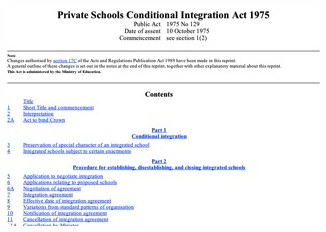Genuine Change or Lip Service
The Ministry of Education's Te Ra Waldorf School Report

The Ministry of Education's "Final report of investigation into a complaint against Te Ra School" makes for fascinating reading for those who wish to know what lies under the curriculum of Steiner/Waldorf schools. Its author, Helena Barwick, spoke to many people to get as clear a picture as possible of what was going on beneath the otherwise lovely school environment, and focused specifically on the issues of racism, and the community's reaction to people who raise concerns.
As Sophie Perkins, one of the two teachers who brought the complaint to the Ministry of Education, says that “the whole philosophy of Anthroposophy underpins the pedagogy and the management structure of these schools. On top of that lies the curriculum. The curriculum is a reflected image of the idea of evolving by reincarnating through race.”

Helena Barwick's research found that: “Waldorf pedagogy is based on the child incarnating through three distinctive seven-year cycles; the theory being that an individual repeats in the first twenty years of life the spiritual-cultural evolution that humanity as a whole has undergone historically. An example given is the ‘caves to cathedrals’ picture often cited by teachers when talking with parents.
“It was explained to me that within Waldorf pedagogy young children are believed to be in a state of ‘collective or tribal consciousness’ which directly relates to so-called ‘primitive’ or indigenous cultures. From here the child evolves to a more developed consciousness linked to civilisations such as Indian, Greeks and Romans until, by Class Seven, the child is pictured as person of the renaissance.
“This hierarchy of races places darker-skinned people as naive and lighter skinned people as more enlightened. These two dimensions of evolutionary thought—the evolution through the races and the evolution of the child—are intertwined. The resulting pedagogy and curriculum is set within in a Eurocentric framework which raises concerns about the implications of this for both tangata whenua and others.”
Helena's research on racism was quite thorough, even looking into some conflict on the subject and why such allegations aren't as clear cut as some would like them to be: “Accusations of racism have long dogged the Steiner School movement. These are based on the assertion that Steiner believed that different races were at different levels of the spiritual hierarchy, with ‘Aryans’ being the highest incarnation. [...] However, [there is an] argument that as Steiner’s views developed he increasingly distanced himself from theosophical concepts of racial evolution and that racial categories eventually became marginal to Steiner’s cosmology. If this is an accurate assessment of the shifts in attitude through Steiner’s life and reflected in his writings, a final determination on the extent of racism within Anthroposophy will continue to be difficult.”
She also pinpointed why change is so hard within Steiner schools: “Anthroposophy is a ‘spiritual science’ the spiritual nature of the philosophy makes it somewhat impervious to critique. I was told that Anthroposophists claim Steiner’s original theories and concepts were examined through his ‘exacting clairvoyant scientific research’, something which is difficult to define and even more difficult to question. [...]
“Initially, many thought it would be straightforward to get rid of racism from the pedagogy. The first surprise to them was that most of the Faculty denied that racism was present. [...]
“Although shocked, not all were surprised by the School’s response to the issue given their own experiences of trying to raise these concerns and other issues with the School.
“"I brought up very clearly, in writing, what I thought was wrong. I posed it as questions I wanted answers to. The only answer I got was that I didn’t understand, I had misinterpreted it."
“"Individuals have terrible trouble with the School. It’s not until you get together and talk about it that you realise it’s not just you. Because of the secrecy everyone battles alone." [...]
“"Their [the School’s] way of dealing with the criticism has been to ostracise, vilify and exclude anyone who takes issue with them.
“"For me it came to a head when I saw how Krissy and Sophie were treated. I didn’t want my children to be part of a place where good people can be treated like that."”

What's quite surprising if you buy the kinder, gentler idea associated with Steiner schools, is how absolutely resistant the staff are to change, and this was perfectly demonstrated when the school decided to develop the Declaration Against Discrimination with the help of members of Mana Māori who described the experience as “very painful”:
“Mana Māori went through a three-month process with the School to reach the Declaration which in the end they described as ‘a compromise on both sides’.
“Most disheartening for Mana Māori was that when the Declaration was finalised and Mana Māori wanted to take it back to the parent community for discussion, the School did not wish to make it public. Under pressure from Mana Māori, the School then wanted to simply present it and not enter into dialogue with parents about it. The School did not want Mana Māori to have an active voice in the presentation. It consigned the group to the role of silent support, with a karakia to begin and end the presentation of the Declaration. Mana Māori is of the view that the School’s behaviour at that point contradicted the Declaration.”

Helena concludes by saying it's “clear there is a worldwide debate on the extent and influence of racism within the writing of Rudolf Steiner. It is also clear that the special character of Te Ra School, based explicitly on Anthroposophy and the writing of Rudolf Steiner, is protected through legislation and the School’s integration agreement.”

This protection may appear to let the racist underpinnings of Steiner's pedagogy go unchallenged, but Sophie Perkins sees this differently: “the Education Act and the Treaty of Waitangi trump any integration agreement, and therefore the 'loop-hole' Helena discovered is not actually one, and the Ministry of Education will need to act.”
Although Helena did find clear instances of racism in Steiner's writings, she doesn't feel as if she's found the smoking gun: “the complainants who initially raised the concerns and have pursued this complaint have not been able to provide many specific instances of ways in which racism has been manifest in teaching or behaviour management. However, these complainants have repeated that their prime concern is that those responsible for teaching and nurturing children at Te Ra and in other Steiner institutions in New Zealand are, by their training and background, imbued with a worldview underpinned with a hierarchy of races that sees indigenous races as having lesser value. While this may be so for some or all of those teaching at Te Ra there is currently no requirement or mechanism to audit the beliefs held by teachers in New Zealand’s schools.
“That said, when the concerns were first raised by these complainants, more than two years ago, Te Ra’s response was poor. The problem was denied and those raising it were vilified to the point where their continued involvement with the School became untenable for them and for many others. The School regrets the way the concerns were handled and accepts much responsibility for the poor response that led to many families losing faith in the School.”
What happens next may prove interesting for the Steiner movement. In fact Te Ra stressed to the ministry the “huge amount of energy that teachers, staff, parents, proprietors and others have put in to these issues over the past year”. In addition to this, The Federation of Rudolf Steiner Waldorf Schools in New Zealand issued a statement distancing itself from any racist writings by Rudolf Steiner, but if the racist ideas are such an embedded part of the pedagogy as to influence the various incarnation stages of the children, how will they be able to disassociate themselves from them while preserving their special character?

To illustrate this point, here’s an extract from the statement Mana Māori wrote about their experience with the school which became part of the Ministry's report. It is extremely revealing. “Through the 12 months in which Mana Māori engaged with the issues surrounding these racist ideologies in anthroposophy, the group arrived at the conclusion that anthroposophy is corrupt and dangerous for all people but it has specific implications for the indigenous people of Aotearoa. Mana Māori saw that it creates an environment within the School that is tailored by imperialist ideologies that give the predominantly non-Māori community a skewed perception of Māori and Māori cultural practices, and of what a constructive, healthy and inclusive engagement with the tangata whenua should be.”
When it comes to transparency, “some of those who adhere to Anthroposophy take the view that a full understanding of this “spiritual science” takes 30 years or more. Parents are therefore not expected to attain a true understanding of it and as a result parents’ concerns are often marginalised because their limited understanding of Anthroposophy does not allow them to be equal partners in the discussion of teaching practices, content and child management.”
They appear to have little faith that the changes that the school say are taking place are genuine or will be ongoing: “Mana Māori sees attempts by the School to deal with this matter as belated, weak and devoid of any real understanding or acceptance of the problem. Efforts by the School to address the issue are of a defensive nature and amount to no more than lip service and tinkering with wording.
“Throughout this process Mana Māori saw a clear division develop between those staff and parents who questioned Anthroposophy and the leadership of the School, and the remaining staff who followed the School’s position blindly. The School made clear efforts to present the problem as being the questioning staff and parents, of whom Mana Māori was central, rather than the issue of racism itself. Ideas took a grip in the School community that the dissenters were trying to turn Te Ra “into a Māori School”, or were “trying to destroy our School”. Effectively the School says there is no racism and the statements by Rudolf Steiner are reflective of their time. This was not the experience of Mana Māori over this issue.
“Mana Māori is also concerned about the School’s communications with its community which, according to this group, reflect the School’s reluctance to properly air and debate this issues [sic]. The School has never produced a clear and satisfactory debrief of the issues and has been very reticent in acknowledging to parents why staff have resigned and 29 families have removed their children from the School. When questioned about the exodus, one teacher replied ‘We don’t know why families are leaving’”.
Nevertheless the report also states that the school regrets “that the breakdown in relationships has prevented the complainants and others who have left the School from seeing the progress that has been made.
“"They haven’t been with us on the journey that we have been on. They are demanding the change but they haven’t been here to see that it is happening.”
This sits with the protective non-transparent attitude so often documented. As when parents leaving over issues such as bullying are told, “the kids [...] have all settled down now and are getting on fine”, this is a convenient regret. In the case of Titirangi Rudolf Steiner, the reassurance given to one parent who saw us protesting outside the school, that it was merely parents who were “a bit upset at the school”, turned sour when her own son, entering the same class our child had just been expelled from, was mercilessly bullied himself.
These self-protective projections from Steiner schools seems to crop up again and again. Can a movement so adept at such double-speak really be capable of change? Doesn't the anthroposophical nature of the pedagogy mean that everything must be put back and renormalised as fast as possible, in spite of what Mana Māori describe as lip-service paid to undeniably serious issues?
The renewed attacks we have suffered for commenting on the Listener article, demonstrate only too well the extent of re-normalisation of anthroposophical dogma following evidential challenge.
The photo of Te Ra Waldorf School was taken from the school’s website.
The photo of the Treaty of Waitangi book was taken from Victoria University of Wellington.
The Māori flag was taken from New Zealand History Online.
